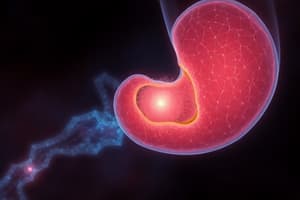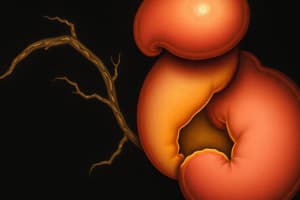Podcast
Questions and Answers
The Neural Plate forms at the caudal end by Day 18.
The Neural Plate forms at the caudal end by Day 18.
False (B)
Neural Crest Cells migrate to form structures like melanocytes and ganglia.
Neural Crest Cells migrate to form structures like melanocytes and ganglia.
True (A)
By Day 21, the Neural Tube closes starting caudally and progressing cranially.
By Day 21, the Neural Tube closes starting caudally and progressing cranially.
False (B)
By Day 28, the Neural Tube is completely closed with both anterior and posterior neuropores sealing.
By Day 28, the Neural Tube is completely closed with both anterior and posterior neuropores sealing.
Ectoderm gives rise to structures such as muscles and bones.
Ectoderm gives rise to structures such as muscles and bones.
Anencephaly results from the failure of the cranial neuropore to close.
Anencephaly results from the failure of the cranial neuropore to close.
The endoderm develops into tissues such as the heart and bones.
The endoderm develops into tissues such as the heart and bones.
Embryonic folding occurs along the cranial-caudal and lateral axes to shape the embryo.
Embryonic folding occurs along the cranial-caudal and lateral axes to shape the embryo.
The Primitive Streak appears on the Epiblast's ventral surface.
The Primitive Streak appears on the Epiblast's ventral surface.
Endoderm is formed from the remaining cells of the Epiblast after gastrulation.
Endoderm is formed from the remaining cells of the Epiblast after gastrulation.
Cranializing factors are released by the Anterior Visceral Endoderm.
Cranializing factors are released by the Anterior Visceral Endoderm.
The Ectoderm forms the innermost layer of the trilaminar germ disc.
The Ectoderm forms the innermost layer of the trilaminar germ disc.
Goosecoid and Chordin are BMP4 inhibitors that allow dorsal structures to form.
Goosecoid and Chordin are BMP4 inhibitors that allow dorsal structures to form.
The first wave of migration during gastrulation forms the Mesoderm.
The first wave of migration during gastrulation forms the Mesoderm.
Left-Right axis establishment occurs during the differentiation of migrating cells.
Left-Right axis establishment occurs during the differentiation of migrating cells.
Epithelial-Mesenchymal Transition (EMT) involves the loss of cell adhesion, allowing cells to migrate.
Epithelial-Mesenchymal Transition (EMT) involves the loss of cell adhesion, allowing cells to migrate.
The Notochord is responsible for providing rigidity and structural support to the embryo.
The Notochord is responsible for providing rigidity and structural support to the embryo.
The Intermediate Mesoderm is responsible for forming the axial skeleton.
The Intermediate Mesoderm is responsible for forming the axial skeleton.
Prechordal Cells are crucial for the differentiation of the forebrain.
Prechordal Cells are crucial for the differentiation of the forebrain.
The Splanchnic Mesoderm develops into structures of the limb skeleton.
The Splanchnic Mesoderm develops into structures of the limb skeleton.
The Primitive Node and Primitive Streak guide cells from the Hypoblast to migrate inward.
The Primitive Node and Primitive Streak guide cells from the Hypoblast to migrate inward.
The Lateral Plate Mesoderm divides into Somatic and Splanchnic Mesoderm.
The Lateral Plate Mesoderm divides into Somatic and Splanchnic Mesoderm.
The Notochordal Plate merges with the ectodermal layer during development.
The Notochordal Plate merges with the ectodermal layer during development.
The first wave of cell migration includes the formation of the Prenotochordal Process.
The first wave of cell migration includes the formation of the Prenotochordal Process.
Flashcards
Mesoderm
Mesoderm
The layer of cells that will differentiate into different tissues and organs, including muscles, bones, and skin.
Somites
Somites
A group of cells that arise from the mesoderm and form the skeletal muscles, bones, and skin.
Intermediate Mesoderm
Intermediate Mesoderm
The part of the mesoderm that forms the urogenital system, including kidneys and gonads.
Lateral Plate Mesoderm
Lateral Plate Mesoderm
Signup and view all the flashcards
Notochord
Notochord
Signup and view all the flashcards
Notochordal Plate
Notochordal Plate
Signup and view all the flashcards
Prechordal Cells
Prechordal Cells
Signup and view all the flashcards
Prechordal Mesoderm
Prechordal Mesoderm
Signup and view all the flashcards
Neural Plate
Neural Plate
Signup and view all the flashcards
Neural Tube Formation
Neural Tube Formation
Signup and view all the flashcards
Neural Crest Cells
Neural Crest Cells
Signup and view all the flashcards
Neural Tube Closure
Neural Tube Closure
Signup and view all the flashcards
Anencephaly
Anencephaly
Signup and view all the flashcards
Spina Bifida
Spina Bifida
Signup and view all the flashcards
Organ Primordia
Organ Primordia
Signup and view all the flashcards
Embryonic Folding
Embryonic Folding
Signup and view all the flashcards
What is the primitive streak?
What is the primitive streak?
Signup and view all the flashcards
What is the primitive node?
What is the primitive node?
Signup and view all the flashcards
What is the oropharyngeal membrane?
What is the oropharyngeal membrane?
Signup and view all the flashcards
What is gastrulation?
What is gastrulation?
Signup and view all the flashcards
What is the endoderm?
What is the endoderm?
Signup and view all the flashcards
What is the mesoderm?
What is the mesoderm?
Signup and view all the flashcards
What is the ectoderm?
What is the ectoderm?
Signup and view all the flashcards
What is epithelial-mesenchymal transition (EMT)?
What is epithelial-mesenchymal transition (EMT)?
Signup and view all the flashcards
Study Notes
Week 3: Formation of the Trilaminar Germ Disc (Gastrulation)
-
Primitive Streak and Body Axes Formation:
- The primitive streak appears on the epiblast's dorsal surface, initiating gastrulation and defining the cranial-caudal axis.
- The primitive node and oropharyngeal membrane appear. The oropharyngeal membrane will become the mouth, and the primitive streak guides cell migration.
- The primitive streak and node direct cell migration and differentiation, creating the primary germ layers.
-
Formation of Three Germ Layers via Gastrulation:
- Epiblast cells migrate through the primitive streak to form:
- Endoderm: Replaces hypoblast cells from the inner layer.
- Mesoderm: Fills the space between endoderm and ectoderm.
- Ectoderm: Formed from the remaining epiblast cells, forming the outer layer.
- Epiblast cells migrate through the primitive streak to form:
-
Molecular Regulation of Embryonic Axes:
- Cranial-Caudal Axis:
- Caudalizing factors (Nodal, BMP4, WNT) are released at the primitive node (caudal end).
- Cranializing factors (OTX2, LIM1, HESX1, CER-I) are released from the anterior visceral endoderm (AVE) to inhibit caudalizing factors in the cranial region.
- Dorsal-Ventral Axis:
- BMP4 promotes ventral development throughout the embryo.
- Inhibitors (Goosecoid, Chordin, Noggin, Follistatin, Nodal) regulate dorsal development.
- Left-Right Axis:
- Defined by specific gene expression.
- Cell migration and differentiation establish the left-right axis.
- Cranial-Caudal Axis:
-
Epithelial-Mesenchymal Transition (EMT):
- Epiblast cells transition to mesenchymal cells, migrating to form the three germ layers.
- EMT involves a loss of cell adhesion (e.g., E-cadherin), enabling cell migration and formation of mesoderm and endoderm.
-
Endoderm and Mesoderm Formation:
- Details about the formation of endoderm and mesoderm were not included in the provided text.
Week 3-4: Mesoderm Differentiation and Notochord Development
-
Mesodermal Layer Specialization:
- Paraxial Mesoderm: Forms somites (muscles, axial skeleton, dermis).
- Intermediate Mesoderm: Forms urogenital structures.
- Lateral Plate Mesoderm: Divides into somatic (limb skeleton, body cavity linings) and splanchnic (heart, blood cells, gut walls) mesoderm.
-
Notochord Formation:
- Primitive node and primitive streak guide inward migration of cells to form the notochord.
- Cells migrating cranially from the primitive node form prechordal mesoderm which develops into prechordal cells, influencing forebrain development.
- Cells from the primitive node form the prenotochordal process which eventually merges with the endoderm to form the notochordal plate.
-
Prechordal cells and Prechordal Mesoderm:
- Migrate cranially from the primitive node and the primitive streak, forming the prechordal mesoderm, which is located near the developing head region.
- Contribute to head formation and influence forebrain development.
Days 17-21: Formation of Neural Plate and Neurulation
-
Neural Plate and Neural Tube:
- The neural plate, induced by signals from the notochord, forms at the cranial end (day 18).
- The neural plate folds to form the neural tube, the precursor to the brain and spinal cord.
-
Neural Crest Cells:
- Form at the edges of the neural folds and migrate to form various structures (melanocytes, ganglia, Schwann cells, adrenal medulla).
- Neural tube closure begins cranially and progresses caudally by day 21.
Day 21-28: Completion of Neural Tube Closure and Organ Primordia
-
Completion of Neural Tube and Early Organ Formation:
- Neural tube closure is complete by day 28, with sealing of anterior and posterior neuropores.
- Initial organ structures (otic placodes, pharyngeal arches, pericardial bulges) become visible.
-
Derivatives of Germ Layers:
- Ectoderm: Epidermis, hair, nails, mammary glands, nervous system components.
- Mesoderm: Muscles, bones, urogenital system, cardiovascular system.
- Endoderm: Gastrointestinal tract, liver, pancreas, lungs.
Week 4: Pathologies and Embryonic Development
-
Potential Developmental Defects:
- Anencephaly: Failure of cranial neuropore closure, often fatal.
- Spina Bifida: Failure of caudal neuropore closure, affecting spinal cord development.
- Sirenomelia (Mermaid Syndrome): Fused lower limbs due to insufficient mesoderm development.
- Sacrococcygeal Teratoma: Tumor from pluripotent cells in the notochord.
-
Preventive Measures:
- Folic acid supplementation reduces risk of neural tube defects.
-
End of Embryonic Period:
- Basic embryo structure with primary organ primordia is established by the end of week 4, marking the end of gastrulation.
Studying That Suits You
Use AI to generate personalized quizzes and flashcards to suit your learning preferences.




